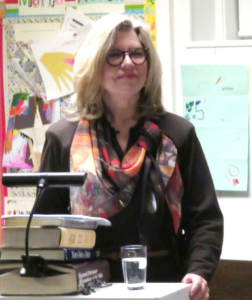A.Y. Jackson – His Manotick Years, 1955-1963

Speaker: Irene Staron. Article by Susan McKellar. February, 2018
Our February speaker, Irene Staron, lives with her husband Al Smith in the studio/dwelling built by Jackson in Manotick in 1955 (of course, renovated since she purchased it in 2006). She took her audience on a multi-dimensional tour – of Jackson’s life and art, the connections she has with him, and the house – accompanied by a succession of striking images..
Irene’s passions are design, lifestyle trends, nature and technology, and design is her business. Her Russian parents immigrated to Canada and established a family in a home filled with art, music and literature. The family also spent much outdoor time in the Lake Simcoe and Georgian Bay areas, hiking in the woods and sketching on the shore. Other early influences included a good art teacher and a visit to the modern, exciting Expo 67. Later when she studied at Ryerson in Toronto she spent time in the neighbourhood of the Toronto studio of the Group of Seven.
Born in Montreal in 1882, Alexander Young Jackson worked at lithograph companies and studied art in Montreal and Chicago, then studied Impressionism in France. The National Gallery of Canada purchased one of his early paintings. In 1913 the Montreal Art Gallery held an exhibition of his work. He was considering moving to the United States, but fellow artist J. E. H. MacDonald convinced him to stay in Canada. He moved to Toronto, continued painting and met other artists. He shared a studio with Tom Thomson and became good friends with him. They and other painters took sketching trips to Georgian Bay, etc.
He served in World War I and was wounded; he was transferred to the Canadian War Records branch as an artist for the remainder of the war, then returned to Toronto. He became part of the informal Group of Seven. The Beaver Hall Group was formed in Montreal in 1920 with Jackson as president. Individual expression was important for this group. The group included women artists, and he developed friendships there. He became a lifelong friend of Ann Savage, exchanging 300 letters. Staron feels the relationship was based on true affection and respect, in spite of the fact that he proposed and she declined. He never married.
In 1955 when Jackson was 72, he moved to Manotick on the advice of Lawren Harris, and built a home and studio there. He had nieces and nephews as well as colleagues in the area. He continued painting, and held soirees for friends, colleagues and people of note. They would be drinking and smoking and talking, and Jackson would ask for their opinion of various paintings. If he got a negative opinion on one, apparently he would throw it into the fireplace.
Over a thousand lots of his paintings have been sold worldwide. The Firestone Collection includes 25 sketches of the Ottawa Valley. Jackson’s autobiography, A Painter’s Country, includes a map of the places where he has painted, many of which are familiar to Staron. She notices a change in his palette in his later years.
After suffering a stroke, he sold his home to Hubert Rogers; Rogers was born in Alberton, P.E.I., where Staron’s husband’s father was born – another connection! Jackson’s final home was in Kleinburg, in the McMichaels’ home, from 1967-73.
In 1987 his niece Geneva bought the house, and local architect and RTHS member, the late Barbara Humphrys, designed an addition. Staron bought the house in 2006, drawn to it in large part because of its natural setting, with a wide variety of plants on the property. There are stepping stones to another niece’s property, where Jackson was wont to go for dinner. When Jackson built his studio, the view from it was of the river – now it’s of the dense vegetation. Staron says the house and studio have lots of light and space, and she feels his presence there.
There were lots of questions and comments by members of the audience, and one member spoke for the community in expressing delight that an artist is living in and treasuring the house.
